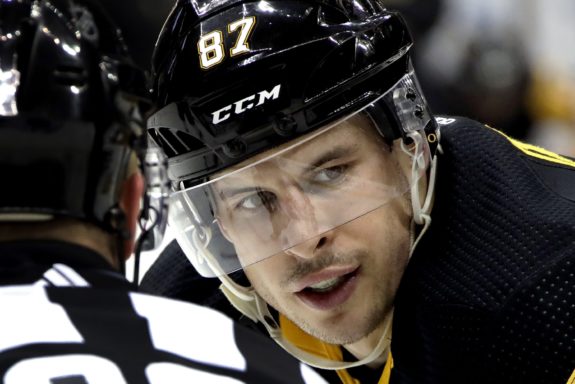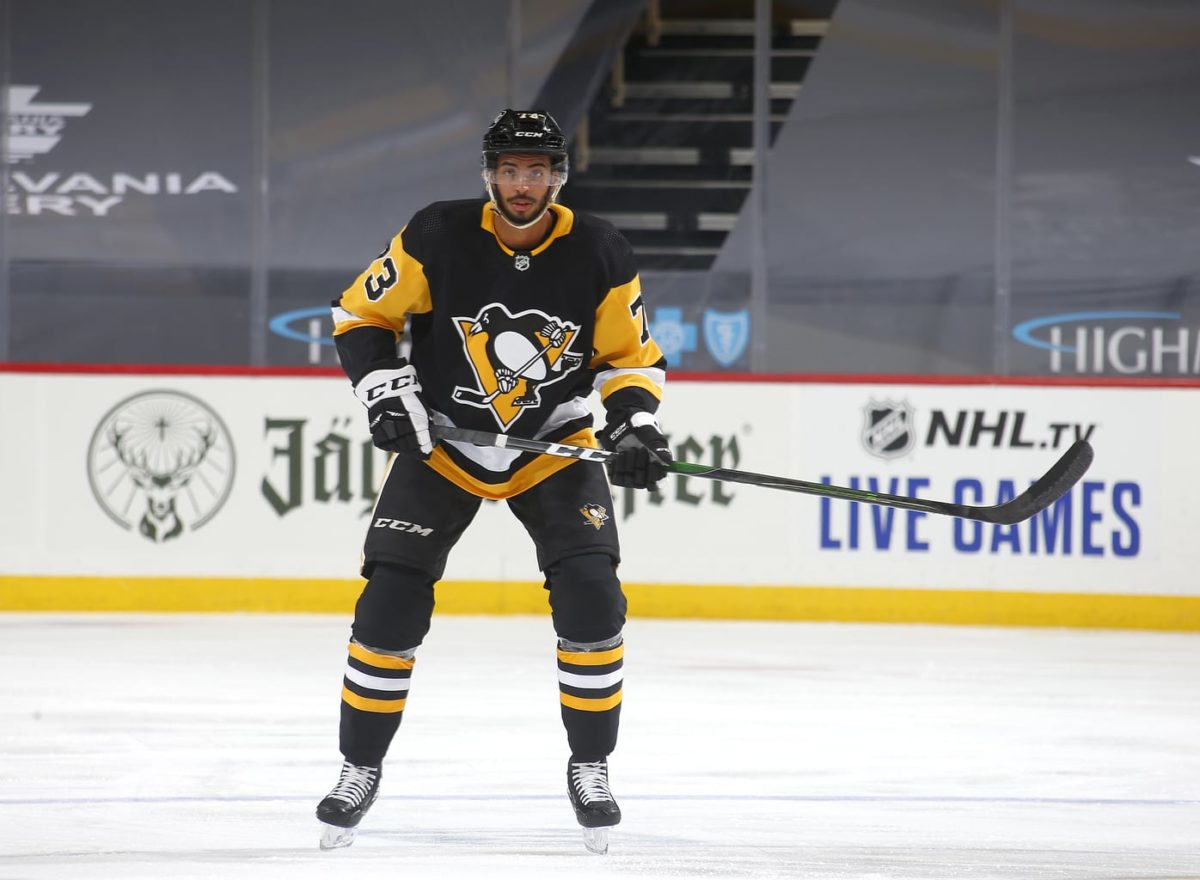To those who managed to suppress their rage at the headline long enough to click through to the commentary, welcome. This is meant to be an honest and rational evaluation of the merits of a potential Sidney Crosby trade for the Pittsburgh Penguins – a franchise-altering move to be sure – and not one that I throw out lightly.
The Penguins have experienced an uncomfortable degree of turbulence in recent seasons, generally unimaginable through most of Crosby’s tenure with the franchise. Yet, an aging and injury-prone core, several playoff disappointments, and a barren farm system expedite the discussions around the unavoidable mortality inherent to any dynasty, with the Crosby-era Penguins being no exception. With protective gear strapped on to repel the inevitable barrage of projectiles thrown in my direction for even suggesting such sacrilege, let’s dive in.
Why the Penguins Won’t Trade Crosby
It’s only fair first to highlight why such a seismic trade likely won’t happen any time soon and provide Penguins’ fans with some assurance in their franchise’s short-term stability. While the team has flopped in consecutive playoff conflicts, their regular season success and the continued presence of their superstars suggest that the team still reports a healthy pulse, which only emboldens management in choosing to stay the course.
The Penguins’ Contention Window Is Still Open
The Penguins’ recent success relative to the rest of the league directly informs which direction president of hockey ops Brian Burke and general manager Ron Hextall will take over their tenure. Since the 2018-19 season, only four teams have accumulated more regular-season victories than the Penguins, with the franchise capturing the hotly-contested East Division title last season. The team withstood vicious challenges to their crown despite Evgeni Malkin only featuring in 33 of their 56 total games, maintaining a positive record during the Russian pivot’s prolonged absence from the lineup.
The underlying numbers driving the black-and-gold machine continue to paint Pittsburgh in a favorable light. According to Natural Stat Trick, the Penguins’ rate as above-average relative to the league in terms of their share of unblocked shots (12th), scoring chances (10th), and chance quality by proxy of expected goals percentage (12th) at five-on-five since the start of the 2019-20 campaign. They’re consistently controlling play and getting a majority of the chances, a reliable recipe for sustained success.

Further, Jake Guentzel (1.05 points-per-game since 2019-20), Bryan Rust (0.86), and John Marino (over 20 minutes of average ice-time; plus-22 rating) have emerged as impactful complementary pieces to the Penguins’ divine trinity. This enviable depth means that the current roster can still joust with the league’s superpowers, even if they grapple with the lengthy absence of one or more of their stars.
In fact, last season’s playoff meltdown could entirely be chalked up to an untimely implosion by Tristan Jarry in the Penguins’ net, with the young goaltender sporting a garish .888 save percentage (SV%) in their first-round bout with the New York Islanders. Pittsburgh thoroughly dominated the Islanders at five-on-five, claiming 58% of the shot-share, 59% of the scoring chances, and nearly 55% of expected goals, but capitulated to the tune of a pitiful 40 percent of the series’ total goals.
If the sentiment around the franchise is that an uncharacteristic dip in performance from an otherwise sturdy net-minder (.914 SV% since 2019-20) should not instigate a full-scale rebuild, the team may understandably gamble on a more favorable roll of the dice come next spring. We all know what happens when you overreact to a short series.
Brian Burke’s Belief in the Penguins Project
A head executive holds the keys to the roster, their feelings guiding the franchise in their roster construction philosophy. When it comes to team president Burke, the use of the word “rebuild” is forbidden in his proximity and therefore reduces the likelihood of a Crosby trade occurring in the near future. His recent comments emphatically signify his perception of the team’s short-term outlook – the Penguins’ window is still wide open.
When you’re brought in to reverse an unsettling trend of shortcoming in the playoffs, patience is not the principal tenet of your competitive philosophy. As Burke insinuates in the short clip, rebuilds are littered with landmines and countless declarations of false hope, and your team could just as easily resemble the Edmonton Oilers of the early-2010s as it could Penguins of the mid-aughts. In the end, tying one’s job and reputation to the uncertain success of the end result proves far too risky to execute a complete demolition of the roster when job security is never fully assured.
You May Also Like:
- Penguins’ Kyle Dubas Already on the Hot Seat This Season
- 4 Things Patrick Roy Can Learn From Jon Cooper & Mike Sullivan
- Pittsburgh Penguins’ 10 Best Defensemen in Team History
- Hockey History – the NHL “Second Six”
- Penguins’ Projected 2024-25 Opening Night Lineup
Why the Penguins Should Trade Crosby
Two things can be true: the Penguins still possess enough firepower to challenge for the Stanley Cup, and it’s time to seriously consider auctioning off their most valuable assets to the highest bidder. The confluence of increased age, a lack of playoff success, and shallow prospect depth collectively play a significant role in this dilemma.
An Aging, Injury-Prone Core
The core of Pittsburgh’s second dynasty is rapidly approaching the tail-end of their peak and slowly succumbing to the physical ramifications of numerous campaigns prolonged by extended playoff runs. Spotty health has dogged the Penguins and their stars, with none of Pittsburgh’s revered triumvirate (Crosby, Malkin, and Kris Letang) failing to avoid injury with any consistency in recent years, and with Crosby and Malkin to miss time while recovering from offseason surgeries.

Relatedly, the gradual passing of time leads to a natural decline in performance, as research on NHL aging curves suggests that a player’s peak production occurs around the age of 25. A quick glance at the Penguins’ roster list tells us that the trio is all older than 34, well beyond the typical pinnacle of a skater’s career. As reliable as their castmates are as a unit, the team currently lacks an individual who could singlehandedly mitigate the loss of Crosby’s total impact. Procuring an external replacement requires parting ways with one of Pittsburgh’s lone treasured assets.
A separate but related factor in this discussion is their individual impact on the team’s salary situation. Letang’s contract is the least burdensome of the three, with his $7.25 million occupying just under 9% of the cap. Both Crosby and Malkin come in at over 10%, but Malkin, like Letang, only has a single year left on his deal. While this article advocates for trading Crosby, the end could instead be nigh for two of Pittsburgh’s pillars, even when accounting for the no-movement clauses (NMCs) attached to their contracts. Their respective cap hits are still within the realm of a proportional return on investment and should invite countless bids if that fateful day ever comes.
On the other hand, it’s just as likely that Malkin and Letang could restructure their expiring contracts to offer invaluable cap space to the Penguins that the Burke-Hextall tandem earmarks for competent reinforcements. Briefly reflect upon the offseason activity of the NBA’s Brooklyn Nets and Los Angeles Lakers; a similar gaggle of Cup-chasing vets flocks to Pittsburgh if tempted with the opportunity to skate alongside two of the century’s best centers. Irrespective of the public sentiment surrounding “super teams,” a prescient executive leverages any advantage stashed in their arsenal.
| Player | 2015-18 | 2018-21 | Rate Difference |
| Sidney Crosby | 1.11 (79) | 1.19 (69) | +0.08 |
| Kris Letang | 0.80 (64) | 0.80 (72) | 0.00 |
| Evgeni Malkin | 1.16 (66) | 1.12 (62) | -0.04 |
If both depart after the 2021-22 season, it becomes increasingly difficult to imagine Crosby wanting to spend the end of his career shepherding the next generation (as admirable of a leader as he is) instead of chasing more Cups to resoundingly cement his already impenetrable legacy. It’s mostly conjecture, sure, but it isn’t easy to believe that someone who exudes his aura of competitiveness silently retreats into the proverbial sunset.
Ultimately, the decision lies with Crosby, as the NMC in his contract means that he dictates his own path and must decide what he values more at this point in his career: winning or stability. His recovery from surgery affords him the time for careful, quiet contemplation over his future. In the end, Father Time triumphs over all.
Recent Playoff Disappointments
The Penguins’ recent postseason results have failed to mirror their regular-season excellence, as they ranked third-last in wins (of the teams who made at least one appearance) since 2018. Additionally, after the second of their successive Stanley Cup wins in 2017, the team has failed to progress past the second round of the playoffs while wilting at the hand of several of their Metropolitan Division foes.
The uncomfortable truth is that Crosby, Letang, and Malkin have not produced at their usual level in the playoffs since their last championship, with a large discrepancy in their playoff scoring rates compared to the regular season. The problem is that the Penguins’ postseason issues do not stem from one particular factor – the stars, supporting cast, defensive structure, and goaltending have each taken turns to star as the primary culprit.
| Player | Regular Season | Playoffs | Rate Difference |
| Sidney Crosby | 1.19 | 0.43 | -0.76 |
| Kris Letang | 0.80 | 0.50 | -0.30 |
| Evgeni Malkin | 1.12 | 0.75 | -0.37 |
It bears keeping in mind that hockey is occasionally prone to bouts of randomness, as is the reality of a sport that is played by batting around a rubber disk on a sheet of slippery ice. The Penguins might have simply been unlucky in winning only one out of five playoff rounds since 2017, and points aren’t everything, but the recent inability to prevail over their post-season adversaries cannot be ignored. Even the most astute executives engage in guesswork when deciding how to weigh results from a small sample over a larger regular-season portfolio, and this case is no different.
A Depleted Prospect Pipeline
The nature of an elongated contention window suggests, nay, demands prioritization of a team’s short-term prosperity as they attempt to maximize the talent they have at their disposal. With Malkin and Crosby, the Penguins possess two of the greatest players of this generation, and not capitalizing on that by mortgaging their future draft capital and pool of prospects is unforgivable. As a long-suffering fan of the Toronto Maple Leafs, I would offer up my first-born child to even sniff the second round of the playoffs, let alone win three Cups this century. No, I don’t need help, why do you ask?
Unfortunately, this myopic view of roster construction is an ill-fated endeavor, as an appraisal of NHL prospects illustrates all too clearly. THW colleague Peter Barachinni released his full evaluation of each NHL franchise’s farm system, with Pittsburgh predictably withering in last place. This comes after the team made only two selections in the first round since 2013, a trend that cripples franchises once the pipeline inevitably runs dry. In fact, of the 100 prospects in his preseason rankings, only two are property of the Penguins: defenseman Pierre-Olivier Joseph (ranked 80th) and winger Samuel Poulin (69th); fine players in their own right, but nowhere near franchise cornerstones.

The enormous haul of assets that a Crosby trade recoups softens the blow, and judging by Crosby’s fourth-place finish in Hart Trophy voting last year, he retains astronomical value around the league, and any general manager salivates at the thought of dropping the Penguins’ icon into their lineup. As the recent state of the Chicago Blackhawks indicates, navigating the years immediately following a dynasty can rapidly go awry, even with a meticulously planned blueprint.
In February, TSN insider Darren Dreger floated the idea of Crosby being traded to the Colorado Avalanche as they looked to vault over the hurdles in their quest for the Cup. Any potential deal revolves around a bounty of picks, prospects, and promising roster players, and Colorado boasts a truly nauseating embarrassment of riches. Penguins fans – does a package involving Bowen Byram, Alex Newhook, and a cornucopia of first-round picks whet your appetite? Avalanche general manager Joe Sakic is no stranger to pulling the trigger on tectonic trades – dismiss him at your own peril.
I don’t have a direct line to Burke or Hextall – maybe for a good reason – but initiating a rebuild on the foundation of such premium assets is alluring, to say the least, and should give pause to anyone who prematurely dismisses the rationale behind these suggestions.
The Penguins’ Perplexing Problem
I imagine that most of you are glowering at your screen after reading this piece as if I suggested that you stash your life savings into the latest cryptocurrency alt-coin. Considering what Crosby means to the city and the franchise, I don’t blame you in the slightest. If management believes that another extended postseason run is forthcoming, Burke and Hextall should keep the core intact. If the franchise’s long-term viability is of greater concern, igniting the rebuild by trading Crosby at close to his relative peak makes too much sense, even if it is emotionally devastating.
It’s all a matter of perspective, but professional sports are an industry that often demands callousness in the face of emotional attachment. Which path do you choose?
